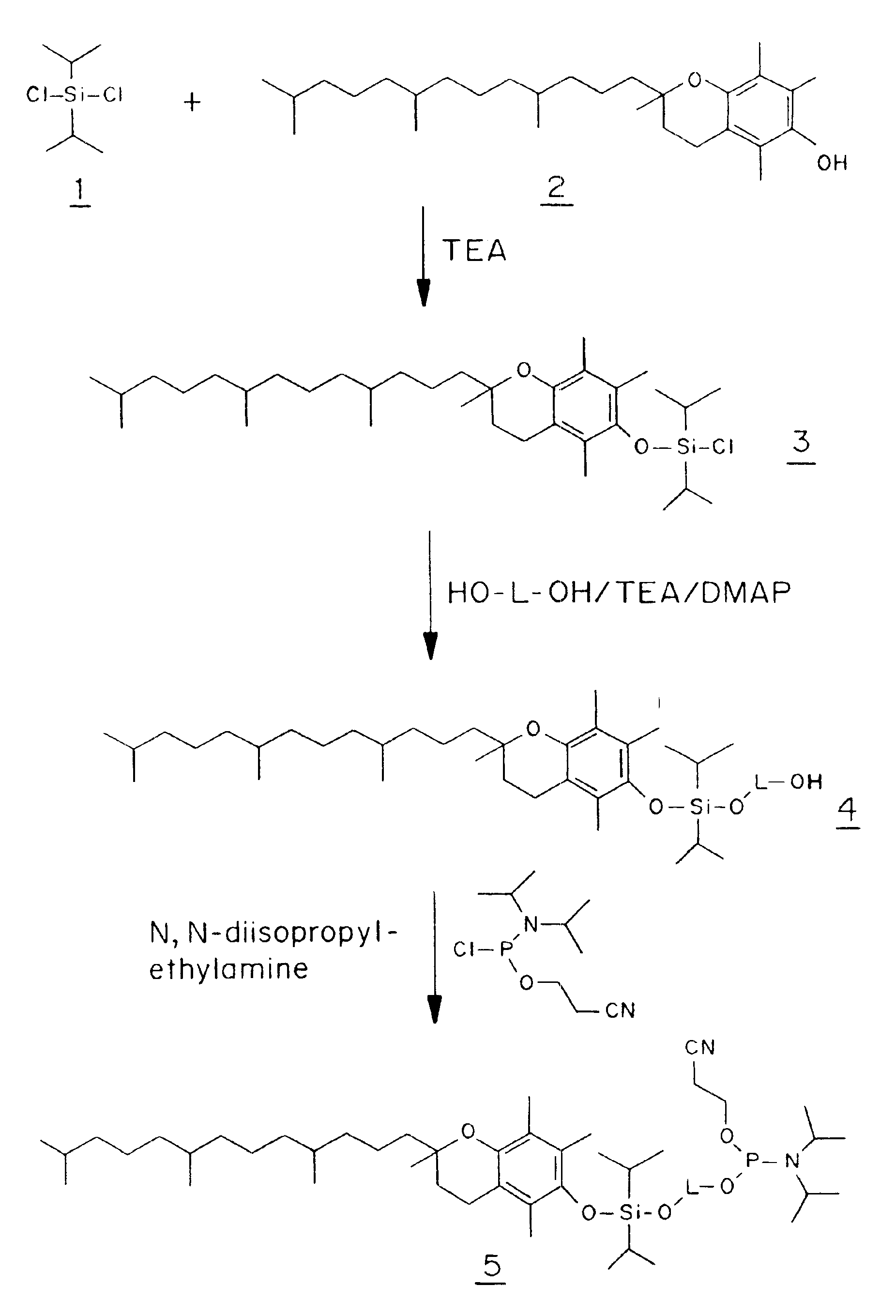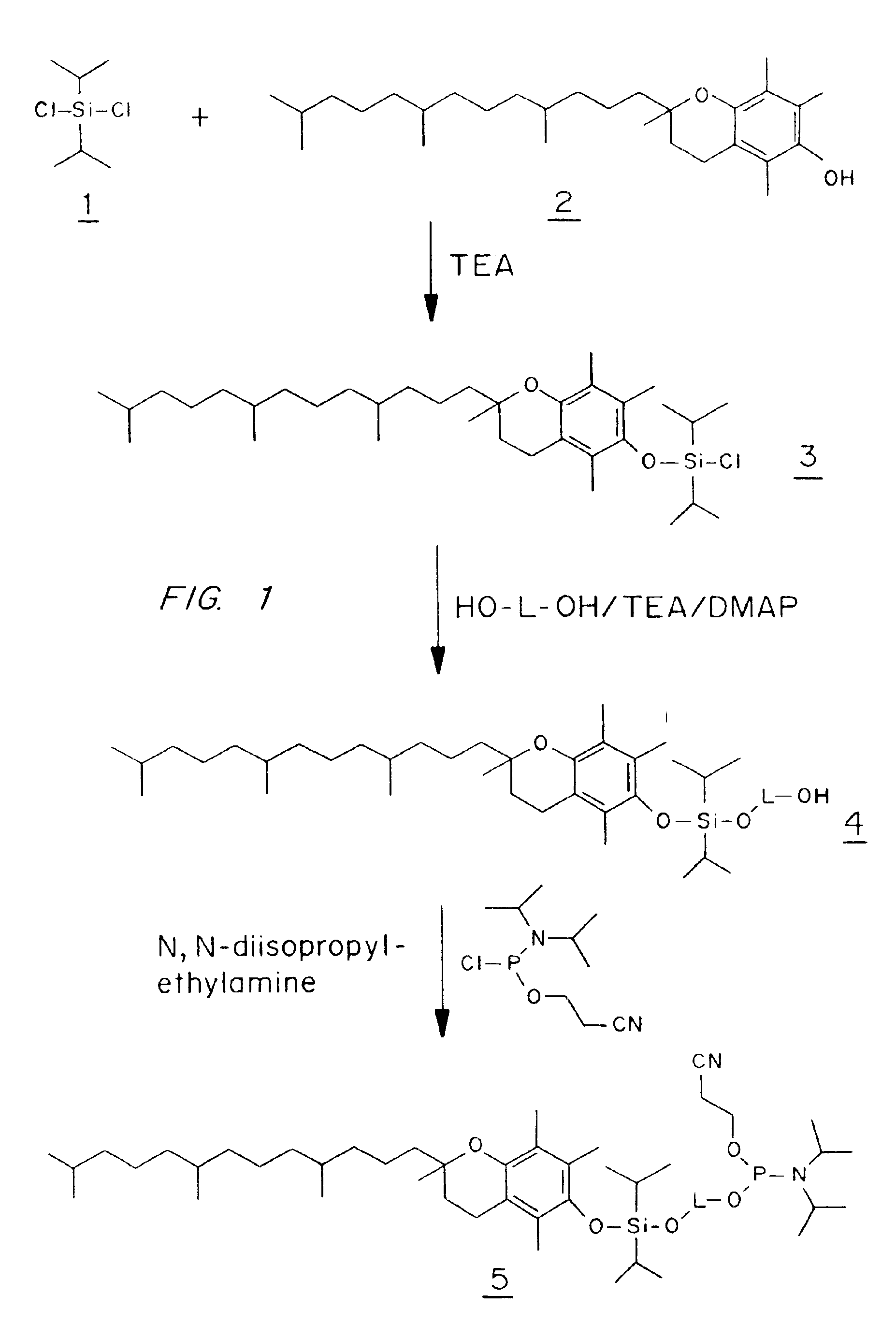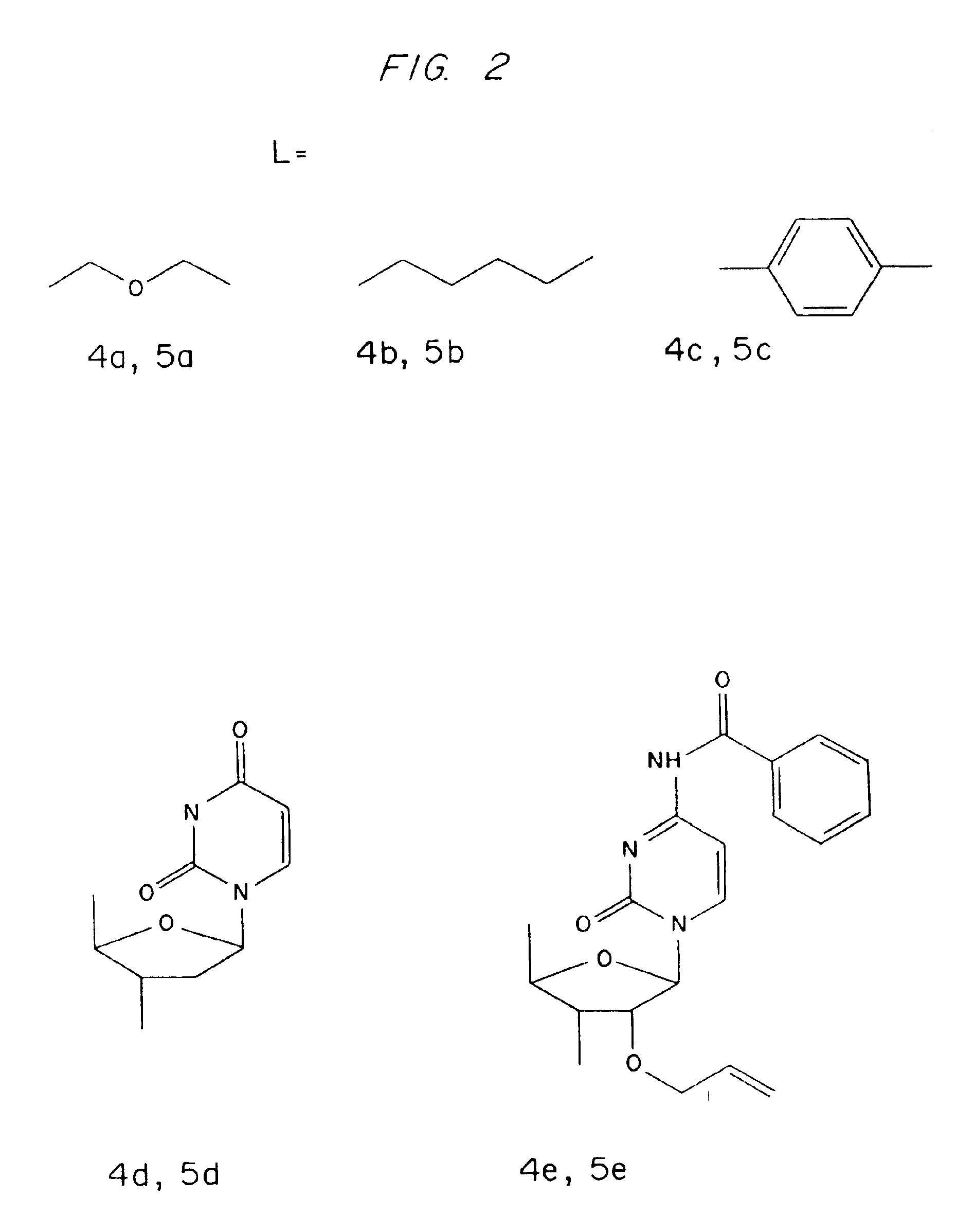Purification of oligomers
a technology of oligomers and purification methods, applied in the field of oligonucleotide synthesis and purification, can solve the problems of failure sequence separation from desired oligonucleotide, one to two percent of hydroxy groups are not successfully coupled, and the resolution of single base oligonucleotides, such as those described above, is typically not possible using these methods, and achieves efficient purification and separation. , the effect of convenient automation
- Summary
- Abstract
- Description
- Claims
- Application Information
AI Technical Summary
Benefits of technology
Problems solved by technology
Method used
Image
Examples
example 1
Diisopropyl(DL-α-tocopheryloxy)chlorosilane (3)
[0093]A solution of DL-α-tocopherol (21.5 g, 50 mmol) in dichloromethane (100 ml) was added dropwise over 30 minutes to a solution of diisopropyldichlorosilane (9.05 ml, 50 mmol) and triethylamine (7.65 ml, 55 mmol) in dichloromethane (500 ml) at 0° C. under anhydrous conditions, and the reaction was then allowed to reach room temperature and was stirred for 1 to 3 days. The solvent was evaporated in vacuo and petrol / diethylether (200 ml, 1:1 v / v) was added to the residue and stirred until the oil dissolved and the triethylamine hydrochloride precipitated. The hydrochloride was filtered off and washed with petrol / diethylether (1:1 v / v) and the filtrate evaporated in vacuo to an oil, which was dissolved to a standard volume in dichloromethane. The combined organics were used directly without purification and assuming a quantitative reaction for the ensuing experiments.
example 2
1-[Diisopropyl(DL-α-tocopheryloxy)silyl]oxy-5-hydroxy-3-oxapentane (4a)
[0094]Diethyleneglycol (4.76 ml, 50 mmol) was dissolved in dichloromethane (125 ml) and triethylamine (2 ml, 15 mmol), and 4-dimethylaminopyridine (183 mg, 1.5 mmol) were added. To this solution was added compound 3 (10 mmol in dichloromethane, see above) and the reaction was stirred overnight at room temperature with exclusion of moisture. The solvent was evaporated in vacuo and the residue dissolved in dichloromethane, washed with aqueous sodium bicarbonate solution, dried (sodium sulfate), filtered and evaporated to dryness in vacuo. Purification on a column of silica gel (3×15 cm) eluting with petrol / ethyl acetate (3:1 v / v) gave compound 4a (2.83 g, 44%) as an almost colorless oil (Rf 0.61 on silica gel TLC in petrol / ethyl acetate (2:1 v / v)). 13C NMR spectrum (CDCl3), δ: 145.83, 144.61, 124.91, 122.52, 122.19, 116.92 and 77.62 (tert. Cs DL-a-tocopheryl), 39.44, 39.18, 37.20 (4Cs), 31.56, 24.60, 24.21 and 20.7...
example 3
1-[Diisopropyl(DL-α-tocopheryloxy)silyl]oxy-6-hydroxyhexane (4b)
[0095]1,6-Hexanediol (14.77 g, 125 mmol), triethylamine (5.2 ml, 37.5 mmol) and 4-dimethylaminopyridine (460 mg, 3.75 mmol) in dichloromethane (100 ml) and N,N-dimethylformamide (25 ml) were reacted with compound 3 (25 mmol) and worked up as described for compound 4a above. Purification on a silica gel column (5×13 cm) eluting with petrol / ethyl acetate (4:1 v / v) gave compound 4b (7.3 g, 44%) as an almost colorless oil (Rf 0.83 on silica gel TLC in petrol / ethyl acetate (2:1 v / v)). 13C NMR spectrum (CDCl3), δ: 145.82, 144.91, 125.16, 122.76, 122.30, 117.11, and 74.28 (tert. Cs toco.), 39.52, 39.32, 37.35 (4Cs), 31.73, 24.74, 24.36 and 20.91 (2Cs) (CH2s toco.), 32.66 (2C) and 27.88 (CHs toco.), 23.62, 22.60 (2Cs), 19.60 (2C), 13.72, 12.84 and 11.86 (CH3s toco.), 63.18 (C-1), 62.56 (C-6), 32.54 (C-2 and C-5), 25.53 (C-3 and C-4), 17.26 (isopropyl CH3s) and 12.84 p.p.m.(isopropyl CHs).
PUM
| Property | Measurement | Unit |
|---|---|---|
| temperature | aaaaa | aaaaa |
| v/v | aaaaa | aaaaa |
| v/v | aaaaa | aaaaa |
Abstract
Description
Claims
Application Information
 Login to View More
Login to View More - R&D
- Intellectual Property
- Life Sciences
- Materials
- Tech Scout
- Unparalleled Data Quality
- Higher Quality Content
- 60% Fewer Hallucinations
Browse by: Latest US Patents, China's latest patents, Technical Efficacy Thesaurus, Application Domain, Technology Topic, Popular Technical Reports.
© 2025 PatSnap. All rights reserved.Legal|Privacy policy|Modern Slavery Act Transparency Statement|Sitemap|About US| Contact US: help@patsnap.com



